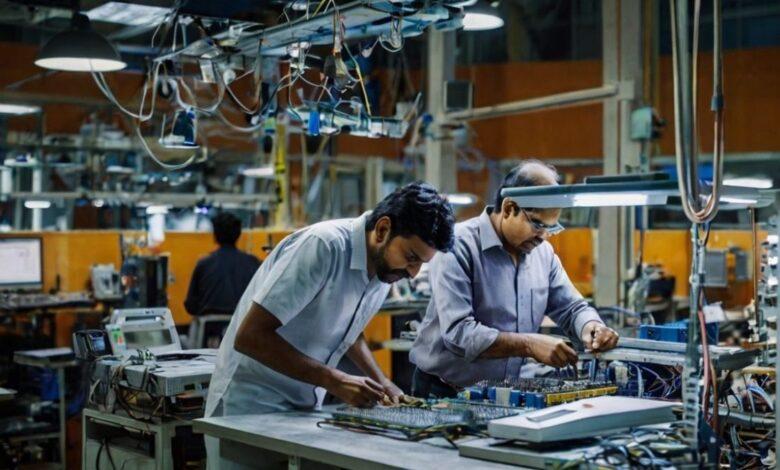India’s Manufacturing Odyssey: From “Make in India” to the “National Manufacturing Mission”

Today, let’s delve into a topic critical for our nation’s future and economic self-reliance: India’s manufacturing sector. We all know how crucial a robust manufacturing sector is for a country to achieve economic prosperity, create millions of jobs, and stand tall with pride on the global stage. This isn’t just about industrial growth; it’s about the dream of self-respect and self-reliance for every Indian. For the past decade, under Prime Minister Modi’s leadership, India has tirelessly worked to fulfill this grand dream, taking significant strides. Let’s meticulously examine this journey. While ambitious programs like “Make in India” laid a strong foundation, we are now moving forward with renewed vigor and higher goals, spearheaded by the “National Manufacturing Mission.”
“Make in India” – The Dawn of Hope, Lessons from Challenges:
When the slogan “Make in India” echoed across the nation in September 2014, it marked a new chapter in our country’s industrial policy. At the time, there was a strong argument that India’s economy was overly dependent on the services sector, with manufacturing not reaching its full potential. With a resolve to fundamentally change this situation, the then-government set an ambitious target: to significantly increase manufacturing’s share in the Gross Domestic Product (GDP) from approximately 16% to 25% by 2022, while simultaneously creating 100 million new jobs in the sector.
To achieve this lofty goal, the central government initiated several progressive measures. It focused on simplifying regulations to facilitate ease of doing business. It devised extensive plans to rapidly develop world-class infrastructure and attract massive investments, both domestic and foreign. Furthermore, it focused on diverse aspects like promoting innovation, upskilling the workforce, and encouraging eco-friendly manufacturing practices. Specifically, it identified 25 key sectors such as automobiles, textiles, chemicals, pharmaceuticals, electronics, and infrastructure, offering special incentives for their growth. Efforts were made to revitalize the manufacturing sector by fast-tracking approvals and establishing industrial corridors and Special Economic Zones.
The “Make in India” initiative truly sparked a positive discussion and widespread awareness in the country. It succeeded in attracting significant Foreign Direct Investment (FDI). Some sectors achieved remarkable growth under this program. For instance, our automotive sector grew steadily, becoming a crucial global hub for vehicle manufacturing. The electronics sector also made good progress, especially in mobile phone manufacturing, where government incentives greatly contributed to local production. India’s significant improvement in the World Bank’s “Ease of Doing Business” index during this period was also a noteworthy positive development, enhancing our country’s credibility internationally.
However, every great journey has its challenges, and “Make in India” was no exception. It yielded mixed results in achieving its primary targets. By 2022, the manufacturing sector’s share in GDP remained between 15-16%, falling short of the 25% target. Despite significant FDI inflows into the country (over $75 billion by 2022), the creation of 100 million additional jobs in manufacturing also remained a formidable goal by the set deadline. Inadequate infrastructure in terms of logistics, power supply, and transportation facilities remained a major obstacle. Often complex and overlapping regulations at both central and state levels continued to pose challenges for businesses. Furthermore, our reliance on imports for crucial components and raw materials in many sectors reduced overall domestic value addition. Fluctuations in global economic conditions and increasing international competition also impacted our growth.
“National Manufacturing Mission” – A Robust Bridge to Future Hope:
Considering the lessons learned and challenges faced through “Make in India,” the Indian government has now announced the “National Manufacturing Mission” with a clearer, more strategic approach. Our Minister for Finance and Corporate Affairs, Nirmala Sitharaman, introduced this mission in the 2025-26 Union Budget. It is set to be fully implemented by July 2025. This is not just a new scheme; it’s a robust bridge to our unwavering resolve to transform our country into a global manufacturing hub. This new mission builds more effectively on the foundation laid by ‘Make in India.’ It specifically focuses on five key aspects:
1. Ease of Doing Business at Lower Cost: This remains one of our top priorities. The mission aims to significantly reduce manufacturing costs in the country by further simplifying regulations, reducing the compliance burden, and granting environmental clearances faster and more transparently. Its main objective is to create a more favorable business environment that not only attracts foreign investors but also enables domestic firms to thrive.
2. Future-Ready Workforce: Recognizing the rapid pace of technological change and the advent of new manufacturing methods like automation, advanced robotics, and Artificial Intelligence, this mission places special emphasis on creating a skilled workforce. This includes massive investments in vocational training institutions, strong partnerships with industry to design relevant courses, and programs to promote research and development in new technologies. Its ultimate goal is to prepare Indian youth with the skills needed for future manufacturing jobs.
3. Efficient and Vibrant MSME Sector: Micro, Small, and Medium Enterprises (MSMEs) are the backbone of our economy, significantly boosting employment and innovation. The National Manufacturing Mission aims to create a better environment for MSMEs’ growth and competitiveness. This includes measures such as improving access to credit, incentives for technological modernization, and creating national and international market linkages. It will also promote digitalization in this sector, integrate them into global supply chains, and support innovation and product development.
4. Technology Availability: Access to cutting-edge technologies is crucial for enhancing the global competitiveness of Indian manufacturing. This mission aims to promote technology transfer, allocate substantial funds for indigenous research and development, and facilitate the adoption of advanced manufacturing methods. This includes establishing technology incubation centers, providing financial assistance for R&D projects, and creating platforms for strong collaboration among industry, academia, and research institutions.
5. Quality Products: To gain market share globally, it’s essential to establish a reputation for manufacturing quality products. This mission aims to raise awareness of quality in the Indian manufacturing sector by adhering to international standards, implementing robust quality control measures, and developing state-of-the-art testing and certification infrastructure. This will not only enhance the competitiveness of Indian products in international markets but also increase consumer trust domestically.
Focus on Additional Sectors:
In addition to these priorities, this mission will specifically focus on and provide special support to certain key strategic sectors. “Clean Tech” manufacturing is a crucial area, clearly demonstrating the country’s commitment to sustainable development and the growing global demand for eco-friendly technologies. The mission aims to make India a major hub for manufacturing solar photovoltaic cells, electric vehicle batteries, motors, controllers, electrolyzers required for green hydrogen production, wind turbines, very high voltage transmission equipment, and grid-scale batteries. These sectors have immense growth potential in the future and will significantly contribute to economic development and environmental sustainability. As part of this mission, a National Action Plan for Toy Manufacturing has been formulated. This initiative aims to establish India as a global hub for toy manufacturing, focusing on developing manufacturing clusters and fostering innovation. Additionally, in the food processing sector, it plans to establish the National Institute of Food Technology, Entrepreneurship and Management in Bihar.
A Cascade of Benefits from the National Manufacturing Mission:
The “National Manufacturing Mission” will bring numerous incredible benefits to our country. As the manufacturing sector develops, it will become a powerful driver of economic growth, significantly contributing to GDP, thereby increasing the overall prosperity of the nation. Increased manufacturing activities will create millions of new jobs across various skill levels, from laborers to engineers. This will address the country’s growing need for employment generation. By promoting domestic manufacturing, especially in strategic sectors, this mission will reduce India’s reliance on imports, making us more economically robust. Focusing on quality and competitiveness will boost India’s manufactured goods exports.
This will not only improve our trade balance but also enhance our position in the global economy. The emphasis on technology adoption and innovation will lead to continuous technological advancement in the manufacturing sector, increasing production efficiency and contributing to the development of new products and processes. A favorable business environment and targeted incentives will attract more domestic and foreign investment in the manufacturing sector, further fueling growth. Investments in skill development and training will create a skilled workforce, enhancing the competitiveness of Indian manufacturers and improving employment opportunities for youth. Crucially, the focus on clean tech manufacturing aligns with India’s commitment to environmental sustainability, positioning the country as a leader in eco-friendly technologies.
Future Course of Action and Challenges:
However, this grand journey may also encounter some challenges. Since many manufacturing-related matters fall under the purview of state governments, coordination between the central and state governments, and policy integration, will be crucial for the mission’s success. Differences in priorities or lack of cooperation could hinder progress. Despite some progress, significant gaps still exist in India’s infrastructure, especially in logistics, power supply, and transportation facilities. These deficiencies increase manufacturing costs and reduce efficiency. Although efforts have been made to simplify regulations, India’s regulatory system may still be complex and time-consuming. Ensuring a truly easy and transparent regulatory environment is vital. The global manufacturing sector is highly competitive, with countries like China and Vietnam already having significant advantages. Indian manufacturers must be highly competitive in terms of cost, quality, and technology to succeed in the global market.
Manufacturers, especially MSMEs, require adequate affordable financial assistance to modernize their technology and expand their operations. Facilitating easy access to credit is crucial. Land acquisition for manufacturing units and obtaining environmental clearances often remain lengthy and challenging processes. Expediting these processes while protecting the environment is important. Technology is rapidly changing, requiring continuous investment in new technologies. Manufacturers must stay abreast of global technological trends.
Global trade conditions and geopolitical tensions can also affect manufacturing sector growth. The mission must be prepared for such external factors.
A Collective Resolve, a Glorious Future:
Our manufacturing odyssey, which began with “Make in India,” is now embarking on new paths with the “National Manufacturing Mission.” This is not merely a government objective; it is the hope and aspiration of every Indian. It is a grand plan for our nation’s future. For this great dream to come true, the government, industries, academic institutions, research organizations, and our young workforce must all work together, with coordination and dedication. If we bravely face the challenges on this journey and remain committed long-term, India’s manufacturing sector is bound to emerge as a leading force on the world map.











